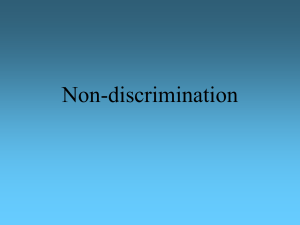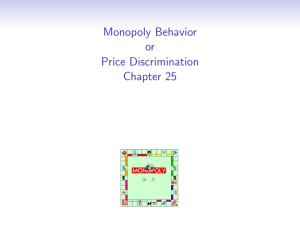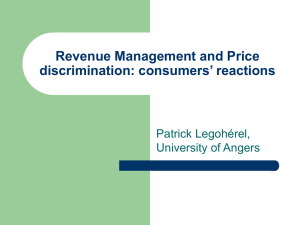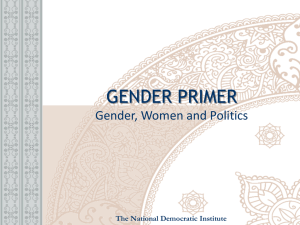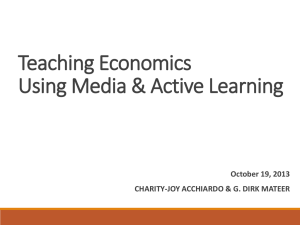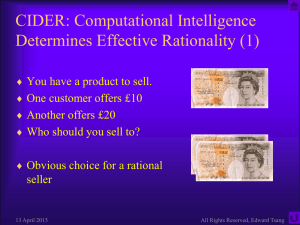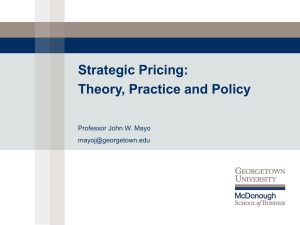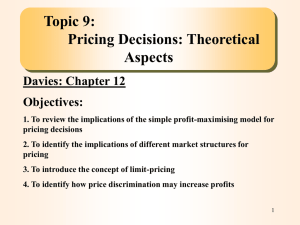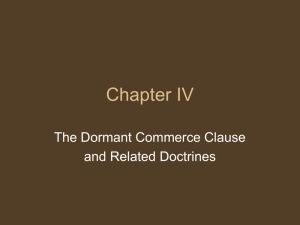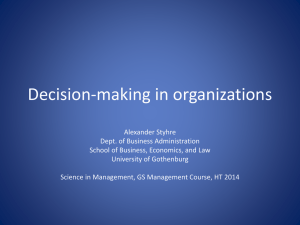Economics and Law Lecture 5
advertisement
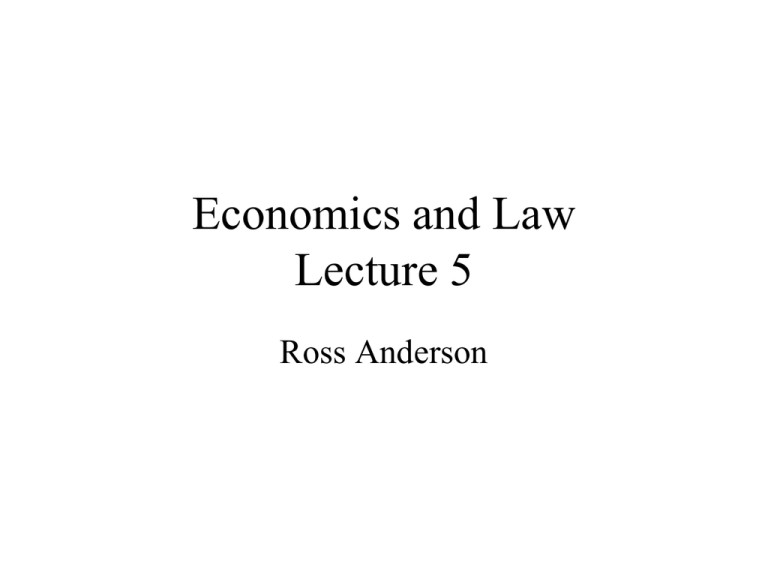
Economics and Law Lecture 5 Ross Anderson Price discrimination • • Recall: an efficient monopolist sells to each customer at her reservation price - ‘selling to value’ Pigou’s three degrees of price discrimination: 1. 2. 3. • • Personalised pricing (e.g. haggling, loyalty cards …) Versioning (e.g. first / business / economy class) Group pricing (e.g. student and OAP discounts) Around for generations – but getting more powerful, more pervasive Tech simultaneously increases the motive and the means Cruel, mean or lavish … It is not because of the few thousand francs which would have to be spent to put a roof over the third-class seats that some company or other has open carriages with wooden benches. What that company is trying to do is prevent the passengers who can pay the second class fare from travelling third class; it hits the poor, not because it wants to hurt them, but to frighten the rich. And it is again for the same reason that the companies, having proved almost cruel to the third-class passengers and mean to the secondclass ones, become lavish in dealing with first-class passengers. Having refused the poor what is necessary, they give the rich what is superfluous. (Jules Dupuit, 1849) Price discrimination (2) • Versioning can include ‘pricing for sharing’, e.g. scientific journals charge libraries more than private readers • Disney DVDs are cheaper than titles you usually rent • Versioning can include marketing incentives – e.g. Wall St Journal online sub free for academics, cheap for students and expensive for business • Much of the promised efficiency gain from ecommerce was based on hope of more effective price discrimination • To what extent did this actually happen? Price discrimination (3) • Price discrimination is in general efficient • E.g. suppose my students and I will analyse a new bank security product for £10,000; we find that Bank A will pay £8000 and Bank £4000 • Uniform pricing means no deal! But if I can set pA = £7500 and pB = $3500 we all win (i.e. Pareto improvement) • But public reaction against discrimination can be strong, especially when the strategy is ‘damaged goods’ and especially when discrimination overt • Even economists are surprised at depth and persistence of discrimination in some markets, e.g. air fares (LondonNew York £300 econ, £3000 business, £6000 first) • One way to conceal discrimination in ‘bundling’ Bundling • Selling a number of products together, as with Microsoft Office • Suppose Alice and Bob have the following reservation prices for Word and Excel Word Excel Alice £100 £150 Bob £150 £100 • With separate pricing, MS would charge £100 per product and get £200 per customer, or £150 and get £150 • By selling them together, it gets £250 • Can also sell different bundles (Office vs Works) Asymmetric information • Recall Akerlof’s ‘market for lemons’ – 100 cars for sale – 50 good cars worth $2000, 50 lemons worth $1000 – Buyers can’t tell difference so price $1000 • One fix is for sellers to offer a warranty – this is cheaper for owners of good cars, so can act as a ‘signal’ for the hidden information • Labour markets too – it’s hard for employers to tell smart diligent employees from interview, so use education as a signal • Signalling theory is also important for recommender systems – Google, eBay, Grameen Asymmetric information (2) • Do Volvo drivers have more accidents because: – Bad drivers buy a Volvo to survive accidents better – Volvo drivers compensate for safety by driving faster? • The first effect is ‘adverse selection’ and the second ‘moral hazard’: examples of ‘hidden information’ versus ‘hidden action’ • Lemons market: trashed by adverse selection • Insurance markets can also be trashed by moral hazard; hence excess, no-claims bonus, … • Moral hazard can lead to surveillance, rationing Transaction costs • Trades are not free! Time & effort; commissions; search; bargaining; policing and enforcement • Ronald Coase (1930s): why do some sectors have large companies, and others small firms? External transaction costs higher than internal ones • Oliver Williamson (1980s-90s): determinants are frequency, specificity, uncertainty, limited rationality, and opportunistic behavior • Again, a big promise of the dotcom boom was to cut transaction costs via efficient B2B markets • So should tech make firms smaller on average? Bounded rationality • People offered £10 or a 50% chance of £20 usually prefer the former; if offered a loss of £10 or a 50% chance of a loss of £20 they usually prefer the latter! • Kahneman and Tversky’s “prospect theory” seeks to explain this via mental heuristics and biases • That’s why marketers talk ‘discount’ or ‘saving’ – framing actions to make them more attractive • The misperception of risk is a big deal (terrorism) • ‘Behavioural economics’ studies all this stuff Bounded rationality (2) • Herb Simon coined ‘bounded rationality’ in the 1950s along with ‘satisfice’ • A satisficier will work hard until his lifestyle goals are met, then slack off. Most of us are satisficiers, and VCs don’t like us! • Another common rationality bound is ‘hyperbolic discounting’ where people disregard far-future events. Most people have inadequate pension provision • The endowment effect: people generally demand a higher price for something they already own. Innate conservatism, plus sensitivity to change Bounded rationality (3) • Decisions are heavily influenced by framing. E.g. the ‘Asian disease problem’ where the subject is making decisions on vaccination. Two options put to subjects. First: A: “200 will be saved” B: “p=1/3, 600 saved; p=2/3, none saved” • Here 72% choose A over B! • Second option is C: “400 will die” D: “p=1/3, no-one will die, p=2/3, 600 will die” • Here 78% prefer D over C! • Defaults also matter. Most people won’t opt in, or opt out. ‘Libertarian paternalism’ is about setting socially optimal defaults (e.g. you have to opt out of pension schemes)




